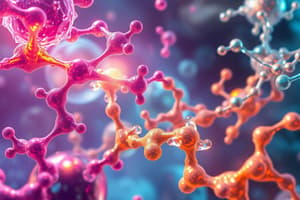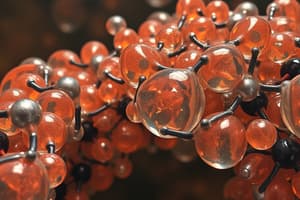Podcast
Questions and Answers
What effect does decreasing the number of double bonds in an oil have on its physical state?
What effect does decreasing the number of double bonds in an oil have on its physical state?
- The oil now contains fewer fatty acids, making it a lighter liquid.
- The oil has a higher melting point, making it solid at room temperature.
- The oil is more likely to be solid at room temperature. (correct)
- The oil becomes more viscous due to an increase in double bonds.
Which of the following statements is true regarding cellulose?
Which of the following statements is true regarding cellulose?
- Cellulose can be broken down easily by the human digestive system.
- Cellulose is a type of nucleic acid that carries genetic information.
- Cellulose is a type of protein that provides energy.
- Cellulose is classified as a carbohydrate and is non-digestible. (correct)
Which characteristic does NOT apply to saturated fats?
Which characteristic does NOT apply to saturated fats?
- They can be packed tightly together.
- They tend to be liquid at room temperature. (correct)
- They contain the maximum number of hydrogens per carbon.
- They have straight carbon-hydrogen backbones.
What is primarily stored in the chemical bonds of macromolecules?
What is primarily stored in the chemical bonds of macromolecules?
Which of the following describes a polymer?
Which of the following describes a polymer?
Why do humans have a preference for foods high in fat?
Why do humans have a preference for foods high in fat?
Which of these macromolecules contains carbon and is essential for life?
Which of these macromolecules contains carbon and is essential for life?
What is a primary distinction between monomers and polymers?
What is a primary distinction between monomers and polymers?
In terms of energy content, how do fats compare to carbohydrates?
In terms of energy content, how do fats compare to carbohydrates?
What characterizes saturated fats in terms of their molecular structure?
What characterizes saturated fats in terms of their molecular structure?
Which of the following is a key benefit of unsaturated fats compared to saturated fats?
Which of the following is a key benefit of unsaturated fats compared to saturated fats?
Why do humans have a preference for foods rich in lipids?
Why do humans have a preference for foods rich in lipids?
What is one primary reason for the use of partially-hydrogenated vegetable oils?
What is one primary reason for the use of partially-hydrogenated vegetable oils?
Which of the following types of carbohydrates is primarily used for immediate energy?
Which of the following types of carbohydrates is primarily used for immediate energy?
What distinguishes complex carbohydrates from simple sugars?
What distinguishes complex carbohydrates from simple sugars?
What happens to the double bonds in vegetable oils during partial hydrogenation?
What happens to the double bonds in vegetable oils during partial hydrogenation?
What is a commonly known function of cellulose in the human diet?
What is a commonly known function of cellulose in the human diet?
What characteristic of unsaturated fats affects their physical state at room temperature?
What characteristic of unsaturated fats affects their physical state at room temperature?
Which type of fat is more likely to be readily used for energy by the body?
Which type of fat is more likely to be readily used for energy by the body?
Explain how the modification of vegetable oil during processing affects its physical properties, particularly at room temperature.
Explain how the modification of vegetable oil during processing affects its physical properties, particularly at room temperature.
Describe the primary structural difference between monomers and polymers in the context of macromolecules.
Describe the primary structural difference between monomers and polymers in the context of macromolecules.
What role do non-digestible fibers, such as cellulose, play in the human diet?
What role do non-digestible fibers, such as cellulose, play in the human diet?
Analyze the evolutionary significance of humans' preference for foods high in fat.
Analyze the evolutionary significance of humans' preference for foods high in fat.
What distinguishes saturated fats from unsaturated fats on a molecular level?
What distinguishes saturated fats from unsaturated fats on a molecular level?
Flashcards
Partially Hydrogenated Vegetable Oil
Partially Hydrogenated Vegetable Oil
Vegetable oil with some of its carbon-carbon double bonds reduced during processing.
Saturated Fat
Saturated Fat
A fat with the maximum number of hydrogen atoms bonded to its carbons; usually solid at room temperature.
Unsaturated Fat
Unsaturated Fat
A fat with one or more carbon-carbon double bonds, typically liquid at room temperature.
Cellulose
Cellulose
Signup and view all the flashcards
Macromolecule
Macromolecule
Signup and view all the flashcards
Monomer
Monomer
Signup and view all the flashcards
Polymer
Polymer
Signup and view all the flashcards
Lipid
Lipid
Signup and view all the flashcards
Carbohydrate
Carbohydrate
Signup and view all the flashcards
Taste Preferences
Taste Preferences
Signup and view all the flashcards
Partially Hydrogenated Oil
Partially Hydrogenated Oil
Signup and view all the flashcards
Monosaccharides
Monosaccharides
Signup and view all the flashcards
Polysaccharides
Polysaccharides
Signup and view all the flashcards
Fast Energy Source (Carbs)
Fast Energy Source (Carbs)
Signup and view all the flashcards
Slow Energy Source (Carbs)
Slow Energy Source (Carbs)
Signup and view all the flashcards
Lipid Storage
Lipid Storage
Signup and view all the flashcards
Energy Density (Lipids)
Energy Density (Lipids)
Signup and view all the flashcards
What is a macromolecule?
What is a macromolecule?
Signup and view all the flashcards
Why are fats important for survival?
Why are fats important for survival?
Signup and view all the flashcards
What is the difference between monomers and polymers?
What is the difference between monomers and polymers?
Signup and view all the flashcards
What happens to chemical bonds during energy production?
What happens to chemical bonds during energy production?
Signup and view all the flashcards
What are the four main types of macromolecules?
What are the four main types of macromolecules?
Signup and view all the flashcards
Study Notes
Macromolecules Practice Assessment
- Partially hydrogenated vegetable oil has fewer carbon-carbon double bonds, resulting in a decrease in the number of "kinks" in the fatty acid chains and a higher melting point, making the oil more likely to be solid at room temperature.
Non-digestible Plant Fiber
- Cellulose is a type of carbohydrate.
Saturated Fat Characteristics
- Saturated fats do not have double bonds between carbon atoms, resulting in a straight backbone.
- Saturated fats are typically solid at room temperature due to the close packing of triglycerides.
- Saturated fats carry the maximum number of hydrogen atoms per carbon.
Human Taste Preferences for Fat
- Humans prefer foods high in fat because fat stores the most energy per gram compared to other types of macromolecules.
- In the environment of evolutionary adaptiveness (EEA), people needed energy reserves. Thus, they were motivated to consume fats.
- Fat provided heat and insulation for survival.
Fuel from Chemical Bonds
- Chemical bonds store energy, which is released when the bonds are broken.
- New bonds form during chemical reactions, and these bonds store less energy than the bonds broken.
Macromolecule Definition
- Macromolecules are large organic molecules made up of smaller monomers.
- Examples are lipids, carbohydrates, proteins, and nucleic acids.
Lipids
- Lipids are a group of biological molecules that store energy.
- Lipids are efficient at storing energy and act as insulators for the body.
- Lipids are not soluble in water.
- Includes saturated and unsaturated fats.
Saturated Fats
- Saturated fats have single bonds between carbon atoms.
- Saturated fats have straight tails and can be packed tightly together.
- More likely to be solid at room temperature.
- Examples include butter, cheese, and meat.
Unsaturated Fats
- Unsaturated fats have one or more double bonds between carbon atoms.
- Unsaturated fats have kinked tails, allowing decreased packing.
- More likely to be liquid at room temperature.
- Examples include vegetable oil, fish oil, and walnuts.
Carbohydrates
- Carbohydrates are primarily used for energy storage and structure for cells.
- The body prefers carbohydrates for an immediate energy source.
Simple Sugars (Monosaccharides)
- Simple sugars have carbon chains ranging from 3-7 atoms.
- Provide immediate energy.
- Examples include glucose and fructose.
Complex Carbohydrates (Polysaccharides)
-
Complex carbohydrates are made up of linked simple sugars.
-
Provide sustained energy.
-
Examples include glycogen and starch.
-
Cellulose is a type of complex carbohydrate that provides structure for plants.
-
Cellulose is indigestible by humans.
-
Humans cannot break down beta-linkage bonds.
Studying That Suits You
Use AI to generate personalized quizzes and flashcards to suit your learning preferences.




